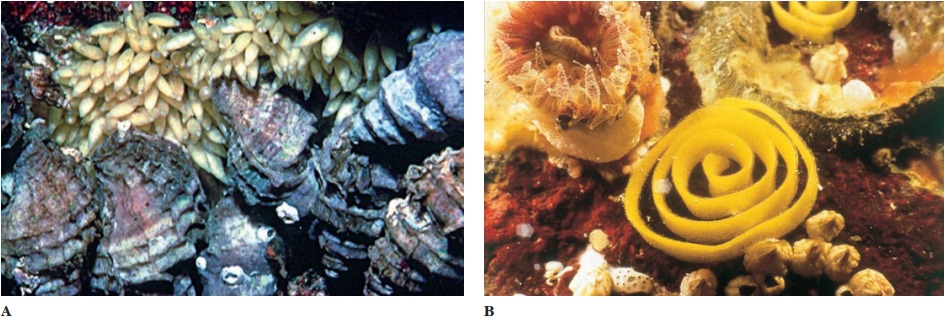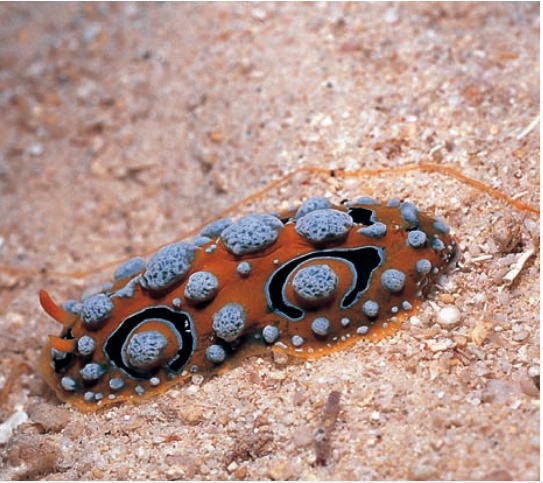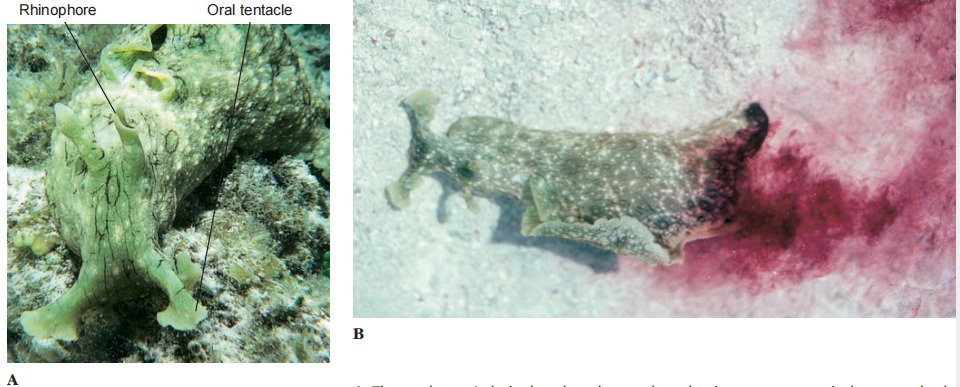Traditional classification of class Gastropoda recognizes three sub classes: Prosobranchia, the largest subclass, almost all of which are marine; Opisthobranchia, an assemblage including sea slugs, sea hares, nudibranchs, and canoe shells, all marine; and Pulmonata, containing most freshwater and terrestrial species. Currently, gastropod taxonomy is in flux. Evidence suggests that Prosobranchia is paraphyletic.
Opisthobranchia may or may not be paraphyletic, but Opisthobranchia and Pulmonata together apparently form a monophyletic grouping. The number of subclasses within the Gastropoda and the relationships among them remain subjects of considerable controversy. For convenience and organization, we continue to use the words “prosobranchs” and “opisthobranchs,” recognizing that they may not represent valid taxa.
This group contains most marine snails and some freshwater and terrestrial gastropods. The mantle cavity is anterior as a result of torsion, with the gill or gills lying in front of the heart. Water enters the left side and exits from the right side, and the edge of the mantle often extends into a long siphon to separate incurrent from excurrent flow. In prosobranchs with two gills (for example, the abalone Haliotis and keyhole limpets Diodora, fouling is avoided by having the excurrent water go up and out through one or more holes in the shell above the mantle cavity.
prosobranchs have one pair of tentacles. Sexes are usually separate. An operculum is often present. They range in size from periwinkles and small limpets ( Patella and Diodora) to horse conchs (Pleuroploca) which grow shells up to 60 cm in length, making them the largest gastropods in the Atlantic Ocean. Familiar examples of prosobranchs include abalones (Haliotis), which have an ear-shaped shell; whelks (Busycon), which lay their eggs in double-edged, disc-shaped capsules attached to a cord a meter long; common periwinkles (Littorina); moon snails ( Polinices); oyster borers (Urosalpinx), which bore into oysters and suck their juices; rock shells (Murex), a European species that was used to make the royal purple of the ancient Romans; and some freshwater forms ( Goniobasis and Viviparus).

Opisthobranchs are an odd assemblage of molluscs that include sea slugs, sea hares, sea butterflies, and bubble shells. They are nearly all marine; most are shallow-water forms, hiding under stones and seaweed; a few are pelagic. Currently nine or more orders of opisthobranchs are recognized. Opisthobranchs show partial or complete detorsion; thus the anus and gill (if present) are displaced to the right side or rear of the body. Clearly, the fouling problem is obviated if the anus is moved away from the head toward the posterior. Two pairs of tentacles are usually found, and the second pair is often further modified (rhinophores,) with platelike folds that apparently increase the area for chemoreception. Their shell is typically reduced or absent. All are monoecious.
Sea hares ( Aplysia, have large, earlike anterior tentacles and vestigial shells. In pteropods or sea butterfl ies( Corolla and Clione) the foot is modified into fins for swimming; thus, they are pelagic. Nudibranchs are carnivorous and often brightly colored. Plumed sea slugs (Aeolidae) which feed primarily on sea anemones and hydroids, have elongate papillae (cerata) covering their back. They ingest their prey’s nematocysts and transport the nematocysts undischarged to the tips of their cerata. There the nematocysts are placed in cnidosacs that open to the outside, and the aeolid can use these highjacked nematocysts for its own defense. Hermissenda is one of the more common West Coast nudibranchs.


Sacoglossan sea slugs are characterized by a radula with a single tooth per row that is used to pierce algal cells, allowing the slug to suck the contents. Similar to their aeolid cousins, some sacoglossans can steal functional organelles from their prey for their own benefit. In fact, many species have evolved special branches of the gut that run throughout the body; photosynthetic plastids from their algal food are directed into these branches rather than being digested, and they continue to function for quite some time. Some carnivorous nudibranchs likewise take advantage of intact zooxanthellae from their cnidarian prey. This ability to usurp the photosynthetic machinery of their prey has led to the nickname “solar-powered sea slugs” for some species (for example, Elysia crispata ).

Pulmonates Pulmonates include land and most freshwater snails and slugs (and a few brackish and saltwater forms). They have lost their ancestral ctenidia, but their vascularized mantle wall has become a lung, which fills with air by contraction of the mantle floor (some aquatic species have developed secondary gills in the mantle cavity). The anus and nephridiopore open near the pneumostome, and waste is expelled forcibly with air or water from the lung. Pulmonates show some detorsion. They are monoecious. Aquatic species have one pair of nonretractile tentacles, at the base of which are eyes; land forms have two pairs of tentacles, with the posterior pair bearing eyes.
Useful External Links



 for biology enthusiasts.
for biology enthusiasts.